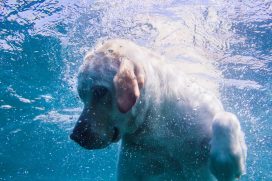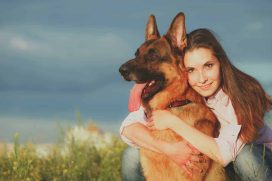The Pitsky Overview
| Height Range | 55 to 62 cm (16 to 26 inches) |
| Weight Range | 14 to 35kgs (30-80lbs) |
| Temperament | Loyal and energetic, enjoy a fast-paced lifestyle, can be demanding |
| Easy To Train | These dogs can be stubborn and require an experienced owner |
| Exercise Needs | 2+ hours daily, the more the better |
| Diet | High-meat, low-carb diet |
| Average Lifespan | 12-15 years |
| Possible Health Concerns | Dysplasia, cataracts, allergies, hypothyroidism, separation anxiety |
Where Does The Pitsky Breed Come From?
The Pitsky is dog breed derived from the parent breeds of American Pit Bull Terrier and Siberian Husky, or the parent breeds of American Pit Bull Terrier and American Husky.
Designer dog breeders first started intentionally breeding the Pitsky in the 1990s.
To be a true Pitsky, the puppy must come from an American Pitbull Terrier and a Husky parent.
Oddly, if you breed a Pitsky with another Pitsky they are not considered a true Pitsky.
How Big Does A Pitsky Get?
Like any crossbreed, the Pitsky can inherit different traits from each parent breed and this in turn will affect the Pitsky puppy’s traits like size and coat.
Male Pitsky are approximately 21 inches tall and can weigh 40-70 pounds.
Female Pitsky are usually a bit smaller that a male, at around 19 inches tall and a weight of around 30-60 pounds.
Given this information, the Pitsky dog breed can be considered a large dog breed.
Is Pitsky Good With Kids?
The Pitsky is not the best choice for a household with kids and other dogs. The Pitsky is best left to experienced dog owners.
This breed can be child-friendly if socialized properly. In fact, they usually love the energy of children.
It is important to teach both the children and the dog what is and what is not appropriate behavior. No sitting on the dog, pulling on the dog, etc. Likewise, no mouthing the kids, pulling on their clothes, or knocking them over.
Be sure that you can dedicate lots of time to this designer dog. They are happiest with their human “pack” and can easily develop separation anxiety. The Pistsky requires a great deal of attention, including obedience training and reinforcement, and will not thrive without it.
How Well Does a Pitsky Do with Other Dogs?
The Pitsky tends to play rough with other dogs and animals. Early and ongoing socialization can help to prevent this. But be safe and always be an active observer with a Pitsky around other dogs or animals.
It can be helpful to know some basic dog body language to know if a dog-dog encounter is going well. Watch the dogs for stiff, very upright movement and a straight-up tail or a hard stare. These are signs that the encounter may not go well and you may want to end it now.
Other things to look at are calming signals. If a dog looks away, licks its lips, yawns, lays or sits down these are all known as calming signals. If you see a dog displaying any of these, he is stressed out and it might be a good idea to end the encounter now.
Is The Pitsky Easy to Train?
The Pitsky breed is not easy to train, especially if a good training habit is not started early. Early socialization and training is a must with the Pitsky. They can be quite stubborn and do best with consistent, positive training.
Pitskys can be aggressive if not socialized and trained early on in life. They need to be introduced to as many sights, sounds, people, animals, locations, as possible. Especially children and other dogs. Even if you do not have children now, you want your Pisky to be prepared should he ever encounter one.
How Much Exercise Does a Pitsky Need?
At least 2 hours of physical activity daily, plus they need mental stimulation. The more exercise you can give them the better. A weighted vest may be helpful to tire the dog faster. But be sure to use a weighted vest wisely, too much weight or weight for too much time could damage joints.
Pitskys are well suited to having some sort of job to do. Perhaps training your dog for competitions like agility, obedience training, treiball, pulling, or canine freestyle would help him burn energy.
This dog needs something to do all the time. If he is not sleeping he needs a job. If a Pitksy is allowed to become board he will become destructive and sometimes aggressive or moody.
Here Are Some Ideas To Keep A Pitsky Occupied:
So, we can’t always be entertaining our dogs. If you can, awesome, you’re the best dog parent ever! For the rest of us, here are a few ideas to keep your Pitsky occupied for a bit, so you can have a minute to yourself.
Hide n’ seek with the kids. This is a great one to keep the dog and the kids out of your hair at the same time. Put the Pitsky in a stay or hold him with you for a minute while the kids hide. Once a child calls him, let him loose to find them and get a little treat. It’s a good idea to have the children indicate somehow that they have been found and it’s time for someone else to call the Pitsky.
Treasure hunts: Get a few small boxes or paper towel rolls, put a treat in each, close it up. Crate your Pitsky or put him out in the yard for a minute while you hide the treasure. You can concentrate them in one room and over time expand to more for more challenge. Make sure one is in plain sight so your dog knows that the game in on. Then just let him go find them all. Be sure not to hide the treasures anywhere too difficult or too high. The Pitsky will get it even if it means destroying things in his path.
Here’s a good one stuffed Kongs or other treat toys. Frozen may be the most challenging and time consuming. Try freezing bone broth or kefir in the kong and let the Pistky go to town on it. These will thaw eventually so be sure your dog is working in an area where it won’t matter too much if he makes a mess.
Recreational bones might be the best one! Recreational bones are weight-bearing, raw bones. They should have a bit of meat on them preferably with some joint tissue or cartilage. A good recreational bone has the potential to offer your Pitsky hours of fun, providing mental and physical stimulation. Plus, it’s good for his teeth.
There are also a few “brain teaser” toys out there for dogs which might work the first time to offer you some time to yourself. But once your Pitsky has figured out that toy once, he will fly through it the second time. So, these may not be the best option for the highly-intelligent Pitsky.
How Often Does a Pitsky Need to be Groomed?
Pitskys can have two different types of coat. Either long like their Husky parent or short like their Pit parent. If the have a short-coated Pitsky brushing a couple of times a week should be sufficient. If you have a Pitsky who inherited its Husky parents long, double coat daily brushing is recommended.
Be sure to brush your Pitskys teeth daily. This will help to ensure that his teeth and gums stay strong and healthy for years to come.
How Long Does The Pitsky Live?
If you take your time to find a good reputable breeder and you take the best possible care of your Pitsky that you can, it will live to about 12-16 years.
What Does a Pitsky Eat and How Much?
Pitskys are high energy dogs and will do best on a high-meat, low-carb diet. If you choose to do competition, like agility or pulling a higher-fat diet may be helpful for sustained energy. Make no mistake, even with a high-fat diet he still needs plenty of meat.
Raw diets are ideally suited to Pitskys providing them with plenty of bioavailable, essential nutrients. It’s also considerably more interesting for them to eat than kibble, which could add a little mental stimulation to his day.
In general, you will feed your Pitsky 2-3% of his ideal body weight daily of raw food. If you compete with your dog you may need to up the food during hard training or competition season.
If you are not ready for raw feeding yet (you should research it though) feed your Pitsky a high-meat diet that is low to no carb. Be sure to check the label and avoid grains, fillers, preservatives, and anything artificial.
Dog food packages can be tricky they may appear to be high-protein but where is that protein coming from?
The protein needs to be coming from meat and not plant foods. Plant foods do not contain as many amino acids as meat. Plant proteins are also way less bioavailable. Even if meat is the first one or two ingredients, check further. Are the next three-four ingredients a legume or other plant protein source? If they are, odds are good that the majority of the protein is coming from plants and not meat.
One sure-fire way to know where the protein is coming from is to look and see if the brand has added vitamin B12. This vitamin is abundant in meat but hard to come by in plant proteins. If they had to add vitamin B12 then the protein is likely coming from plants more than meat.
It is also a great idea to rotate and mix foods/brands/flavors, this can help to reduce the chances of your dog developing an allergy to a specific food.
Be picky about the treats that you choose for your Pitsky too. The best treats will be one ingredient: meat! The meat can be dehydrated or freeze-dried. You can find a good variety of proteins too, but avoid treats made in China.
What are the Main Health Issues with Pitskys Can Have?
Because the Pitsky is a mix of two purebred dogs they can get any of the health issues of either parent breed. It can be helpful to know what their health problems are so you can know what a Pitsky could develop.
American Pitbull Terrier: hip dysplasia, degenerative myopathy, and kneecap dislocation, also, allergies, cataracts, hypothyroidism, and congenital heart defects
Siberian Husky: cataracts and other eye diseases, hip dysplasia, follicular dysplasia (abnormal hair growth), zinc deficiency, hypothyroidism.
The overlaps: hip dysplasia, eye problems, hypothyroidism. If you have a short-haired Pitsky it will be more prone to skin allergies than a long-haired one.
In general, this should be a pretty healthy dog. Especially if you do your part to find a good breeder, feed him well, exercise him like crazy, and give him all the attention and time he desires.
How to Help Prevent Common Pitsky Health Issues
Common Pitsky health issues include:
- Thyroid Problems
- Hip Dysplasia
- Eye Problems
Thyroid Problems: The thyroid is the main producer of hormones in the body. If your Pitsky were to develop hypothyroidism that means that their thyroid is not producing hormones properly. Hormones are required for pretty much everything body function. So, how can we support and protect the thyroid from damage? First, be sure that your dog is getting enough iodine, this is essential from a properly functioning thyroid. Feeding a high-quality raw diet with plenty of added pre and probiotics will go a long way to improve and protect thyroid health. One last super important thing. The thyroid is located on your dog’s neck, in the front on his throat. Something as simple as jerking on a leash attached to his collar can cause damage to the thyroid. So please walk your dog with the leash attached to a harness. I know that the Pitsky can be hard to train and you may be tempted or even encouraged to use a choke chain or prong collar on your dog. But please, please do not. If a regular collar can damage the thyroid how much more damage would a prong or choke collar do. There are other more effective ways to train. If you have a trainer that says you need to use a choke or prong collar, get a different trainer and do not use these collars.
Hip Dysplasia: There are several ways that you can reduce the chances of your dog developing hip dysplasia. The first happens before you even get your Pitsky. Find a good breeder and ask about the history of hip dysplasia in the parents and grandparents, aunts and uncles of the puppies. Once you find a good breeder and puppy the next thing is to NOT spay/neuter your dog too young. Early spay/neuter is often the culprit of joint issues. You can even choose not to spay/neuter at all, just be responsible. Adding in glucosamine rich foods, turmeric, CBD oil, bone broth, probiotics, and fermented food can also help.
Eye Problems: It can be helpful to feed foods that are rich in carotene, orange foods like carrot and pumpkin. A good Omega-3 supplement can also prove beneficial. Adding in antioxidant-rich food is also a good idea for protecting and supporting your Pitsky’s eyes. Also, be sure to protect the eyes in other ways. Put goggles on your when he hangs his head out the window of the car to prevent dry eye and possible eye damage.
How Much Does A Pitsky Cost To Own?
A Pitsky will be similar in cost to other large dog breeds. The first year of being a Pitsky dog owner will likely be the most expensive as you will have to allow for vaccinations, other health costs and setup costs like purchasing housing and accessories. Expect to pay between $1,000 and $1,500 in the first year of being a Pitsky owner. Each year after that a Pitsky will likely cost around $1,000 depending on the type and quality of food you choose to feed it.
Should You Get A Pitsky?
The Pitsky is a great dog for experienced owners. The Pitsjy can make wonderful family dogs and love to be with their people.
However, if you leave them alone for too long without enough mental stimulation, or allow them to become bored and you will have an unhappy and destructive dog on your hands. They require lots of training along with mental and physical activity.





